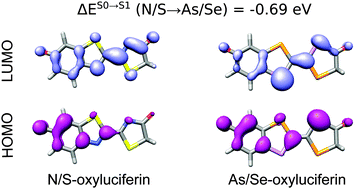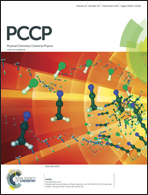Red-shifting the optical response of firefly oxyluciferin with group 15/16 substitutions
Abstract
Time-dependent density functional theory has been used to investigate the effects of group 15/16 element substitution on the optical response of firefly oxyluciferin. A range of analogues containing symmetrical substitutions at the N and S atom positions of the naturally-occurring oxyluciferin have been found to have red-shifted electronic excitation energies with the heaviest derivative investigated (As/Se) displaying a shift of −0.69 eV. Fluorescence emission wavelengths for all P- and As-containing derivatives in DMSO are estimated to lie in the 710–930 nm region making them interesting for bio-imaging applications.


 Please wait while we load your content...
Please wait while we load your content...